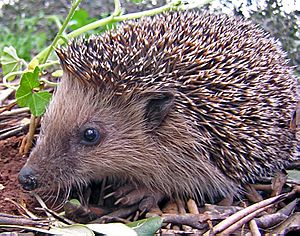Erinaceidae facts for kids
Quick facts for kids ErinaceidaeTemporal range: Eocene to Recent
|
|
|---|---|
 |
|
| A European hedgehog (Erinaceus europaeus) | |
| Scientific classification | |
| Kingdom: | |
| Phylum: | |
| Class: | |
| Infraclass: | |
| Superorder: | |
| Order: | |
| Family: |
Erinaceidae
G. Fischer, 1814
|
Erinaceidae is a group of animals that includes the famous hedgehogs and the lesser-known moonrats. These animals are part of the mammal family. You can find hedgehogs in Europe, Asia, and Africa. Moonrats live in Southeast Asia. Scientists used to group them differently, but now they are part of the Eulipotyphla order. This order includes other small mammals like shrews and moles.
Contents
What Makes Erinaceids Special?
Body Features
Erinaceids often look a bit like large shrews. They have long snouts and short tails. Most of these animals have five toes on each foot. Some even have strong claws that help them dig. They also have big eyes and ears.
Hedgehogs are known for their sharp spines. These spines are actually special hairs. They cover the hedgehog's back and sides. This spiky coat helps protect them from danger. Moonrats, however, have regular hair instead of spines. Many species in this family have special scent glands. These glands can make a strong smell, especially in moonrats.
What They Eat
Erinaceids are omnivores. This means they eat both plants and animals. A big part of their diet is insects and earthworms. They also enjoy other small invertebrates. Sometimes, they will eat seeds and fruit. They might even find and eat bird's eggs or any dead animals they come across. Their teeth are sharp, which is perfect for catching and eating small prey.
Daily Life and Habits
Hedgehogs are mostly nocturnal. This means they are active at night. Moonrats can be active during the day or night. Many erinaceids live in simple burrows they dig. Others build temporary nests from leaves and grass. They might also hide in hollow logs or other safe spots.
Most erinaceids live alone. They only come together to breed. The father does not help raise the young. Female erinaceids are pregnant for about six to seven weeks. The babies are born blind and without hair. Hedgehog babies start growing their spines very quickly, usually within 36 hours of being born.
How Scientists Classify Erinaceids
Scientists have identified 10 different groups, called genera, and 24 species of erinaceids. They are divided into two main subfamilies:
- ORDER ERINACEOMORPHA
- Family Erinaceidae
- Subfamily Erinaceinae (This group includes all the different kinds of hedgehogs.)
- Subfamily Galericinae (This group includes the gymnures, also known as moonrats.)
- Family Erinaceidae
See also
 In Spanish: Erinaceidae para niños
In Spanish: Erinaceidae para niños

